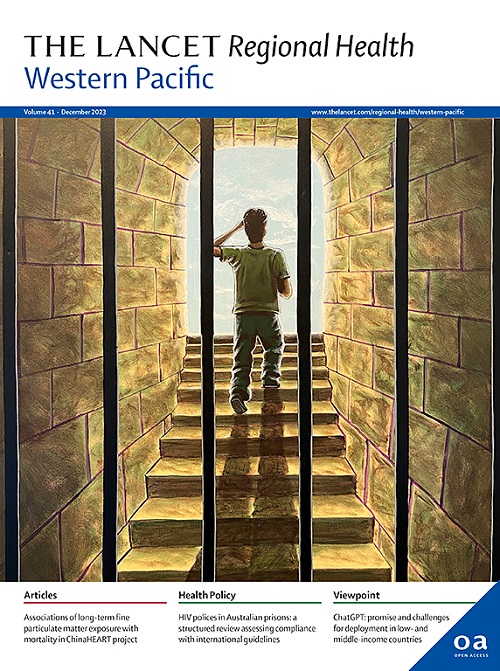Sociodemographic patterns of COVID-19 mortality: the 2020 Japanese census-linked mortality database
IF 8.1
1区 医学
Q1 HEALTH CARE SCIENCES & SERVICES
引用次数: 0
Abstract
Background
Owing to the lack of sociodemographic mortality statistics in Japan, linking existing individual statistical data could be cost-effective and, therefore, highly sustainable for monitoring health inequalities regarding urgent health issues. We investigated nationwide coronavirus disease 2019 (COVID-19) cause-specific mortality by sociodemographic characteristics compared with all-cause mortality in Japan, using our unique linkage method among non-institutionalised citizens.
Methods
Using the 2020 Japanese census-linked mortality database, we calculated age-standardised mortality rates from all-cause and COVID-19 by region, marital status, household size (‘living alone’ to ‘five or more’), educational level, area deprivation index (ADI: municipality-level population quantiles), and occupational class. We then applied multivariable modified Poisson regression analysis to investigate the relationship between all-cause and COVID-19 mortality with sociodemographic characteristics, excluding occupational class. All analyses were performed by sex and period (i.e., during Delta variant dominance in 2021 and Omicron variant dominance in 2022). ADI analyses also accounted for metropolitan residency (the Tokyo and Osaka metropolitan areas vs. non-metropolitan areas).
Findings
This analysis included 80,135,688 non-institutionalised Japanese individuals (aged 30–89 years) linked to 1,895,080 all-cause deaths between October 2020 and December 2022, including 34,213 COVID-19-related deaths. After controlling for sociodemographic characteristics, marital status (e.g., for single men, mortality rate ratio: 2.02 (95% confidence intervals [CI]: 1.90–2.14), compared with married men), and low education level (e.g., low-educated women: 1.49 [95% CI: 1.38–1.61], compared with high-educated women) were associated with increased COVID-19 mortality, similar to the trends in all-cause deaths. Additionally, having a large household was associated with increased COVID-19 mortality rate ratio (e.g., women living with five or more people: 1.69 [95% CI: 1.54–1.84], compared with women living alone; p for trend < 0.0001: using ordinal variables of household size). These patterns were consistent across sexes and variant periods. COVID-19 mortality was not significantly associated with ADI (mortality rate ratio for men in the most deprived municipalities compared with in the least deprived municipalities: 0.95 [95% CI: 0.89–1.01], p for trend = 0.069; women: 0.97 [95% CI: 0.90–1.06], p for trend = 0.285), contrasting with all-cause mortality rate ratios, which increased with deprivation. ADI-related trends varied by variant period and metropolitan status.
Interpretation
In Japan, sociodemographic patterns of COVID-19 mortality for the non-institutionalised population related to marital status and education reflect underlying health inequalities—all-cause mortality patterns. However, the lack of an association with area deprivation marks a divergence from typical all-cause mortality patterns. Notably, residing in large households was uniquely associated with increased COVID-19 mortality, an uncommon feature among cause-specific mortality patterns.
Funding
Japan Society for the Promotion of Science KAKENHI (grant number: 23K16341).
COVID-19死亡率的社会人口统计学模式:2020年日本人口普查相关死亡率数据库
背景:由于日本缺乏社会人口死亡率统计数据,将现有的个人统计数据联系起来可能具有成本效益,因此在监测紧急卫生问题方面的卫生不平等方面具有高度的可持续性。我们通过社会人口学特征调查了全国2019冠状病毒病(COVID-19)病因特异性死亡率,并将其与日本的全因死亡率进行了比较,使用我们独特的关联方法在非机构公民中进行了调查。方法使用2020年日本人口普查相关死亡率数据库,按地区、婚姻状况、家庭规模(“独居”至“五个或更多”)、教育水平、区域剥夺指数(ADI:市级人口分位数)和职业类别计算全因和COVID-19的年龄标准化死亡率。然后,我们应用多变量修正泊松回归分析来调查全因和COVID-19死亡率与社会人口学特征(不包括职业类别)之间的关系。所有的分析都是按性别和时期进行的(即,在2021年Delta变异优势期和2022年Omicron变异优势期)。ADI分析还考虑了大都市居住情况(东京和大阪大都市地区与非大都市地区)。该分析包括与2020年10月至2022年12月期间1,895,080例全因死亡有关的80,135,688名非机构日本人(年龄在30-89岁之间),其中包括34,213例与covid -19相关的死亡。在控制了社会人口学特征后,婚姻状况(例如,单身男性的死亡率比:2.02(95%可信区间[CI]: 1.90-2.14),与已婚男性相比)和低教育水平(例如,受教育程度低的女性:1.49 [95% CI: 1.38-1.61],与受教育程度高的女性相比)与COVID-19死亡率增加有关,与全因死亡的趋势相似。此外,大家庭与COVID-19死亡率增加相关(例如,与独居女性相比,与5人或5人以上生活的女性死亡率为1.69 [95% CI: 1.54-1.84];P代表趋势<;0.0001:使用家庭规模的顺序变量)。这些模式在不同性别和不同时期都是一致的。COVID-19死亡率与ADI无显著相关性(最贫困城市男性死亡率与最贫困城市男性死亡率之比:0.95 [95% CI: 0.89-1.01],趋势p = 0.069;女性:0.97 [95% CI: 0.90-1.06],趋势p = 0.285),与全因死亡率相比,全因死亡率随着贫困而增加。adi相关趋势因不同时期和城市状况而异。在日本,与婚姻状况和教育程度相关的非机构人口COVID-19死亡率的社会人口统计模式反映了潜在的健康不平等——全因死亡率模式。然而,缺乏与区域剥夺的联系标志着与典型的全因死亡率模式的差异。值得注意的是,居住在大家庭中与COVID-19死亡率的增加有着独特的关联,这在特定原因的死亡率模式中是一个不常见的特征。日本科学促进会KAKENHI(资助号:23K16341)。
本文章由计算机程序翻译,如有差异,请以英文原文为准。
求助全文
约1分钟内获得全文
求助全文
来源期刊

The Lancet Regional Health: Western Pacific
Medicine-Pediatrics, Perinatology and Child Health
CiteScore
8.80
自引率
2.80%
发文量
305
审稿时长
11 weeks
期刊介绍:
The Lancet Regional Health – Western Pacific, a gold open access journal, is an integral part of The Lancet's global initiative advocating for healthcare quality and access worldwide. It aims to advance clinical practice and health policy in the Western Pacific region, contributing to enhanced health outcomes. The journal publishes high-quality original research shedding light on clinical practice and health policy in the region. It also includes reviews, commentaries, and opinion pieces covering diverse regional health topics, such as infectious diseases, non-communicable diseases, child and adolescent health, maternal and reproductive health, aging health, mental health, the health workforce and systems, and health policy.
 求助内容:
求助内容: 应助结果提醒方式:
应助结果提醒方式:


